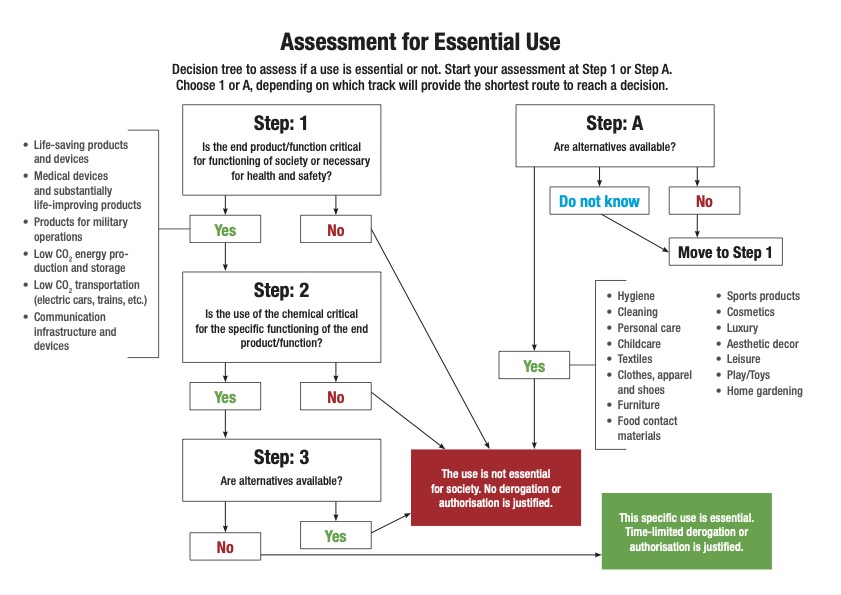1. Which are the most harmful substances?
The most harmful substances are identified in the Chemicals Strategy as “chemicals that cause cancers, gene mutations, affect the reproductive or the endocrine system, or are persistent and bioaccumulative; chemicals affecting the immune, neurological or respiratory systems and chemicals toxic to a specific organ”.
What this means more concretely – in terms of hazard classes and specific substances – has not been clarified by the Commission. In our view, such a clarification would help the discussion forward. As for now, every stakeholder is making its own assumptions about which substances are concerned, to understand what the implications could be.
Some industry lobbyists seem to deliberately misunderstand that introducing the Essential Use concept would be the end to all uses of all chemicals. Over and over again, we hear some good old classic arguments, like “everything is made of chemicals”, “there are chemicals in nature as well”, and “salt can kill you too”.
By more clearly identifying the “most harmful chemicals”, the discussions could hopefully progress beyond these infantile arguments. (We understand the “Most Harmful Substances” to be substances that fulfil SVHC criteria, meaning CMR 1a and 1b, PBTs, vPvPs, PMTs, vPvMs and EDCs. In addition, there are respiratory sensitizers, specific organ toxicity 1 and 2, neurotoxicants and immunotoxic substances.)
2. “Essentiality” needs to be proven on several levels
Defining what is and isn’t essential use requires an assessment in several steps. Essentiality needs to be proven at different levels, and from different angles.
We think it makes sense to start from the angle of the end-use or product category. We need an upfront listing of end-use categories necessary for health and safety, or critical for the functioning of society. This list must be established through a democratic, policy-level decision. The advantage of starting with a list is that it efficiently limits the number of cases to be brought up for lengthy discussions. It also provides clarity to the industry.
However, this approach should of course not be used as a way to justify all uses of the most harmful substances, simply because something belongs to the critical end-use category. Additional levels need to be looked at.
Secondly, an assessment of whether the harmful chemical is needed to fulfil the critical function should be made. The third step should be an investigation of available alternatives. To make the process more efficient, the assessment could also begin with the search for alternatives.
Example: Low CO2 emission transportation (for example electric cars) might be regarded as critical for the functioning of society. The use of PFAS as stain repellent in the car seat is not critical for the end function – the low CO2 emission transportation. The use of PFAS in the circuit board, on the other hand, might be critical for the end function of the electric car. If it is critical, an alternatives assessment needs to be made. Only if there are no alternatives available should PFAS in the circuit board of the electric car be regarded as “essential use”.
However, there should be a temporary derogation for this essential use, to make sure there are incentives in place to develop and innovate alternatives to PFAS in circuit boards. It’s important to note that PFAS in circuit boards of toys are not essential, since there are toys without circuit boards. In addition, it’s never justified to use the most hazardous chemicals in toys.
The following image is a proposed decision tree, based on how we believe essential use assessments should be done. The decision tree also includes examples of end-uses/functions where we know alternatives are available and therefore cannot be regarded as essential use. Moreover, examples of functions/end-uses critical for the functioning of our society and necessary for human health are also present in the decision tree, to provide clarity and predictability. We suggest that the Commission further improve these aspects by adding more examples.

3. Assessing alternatives is key, but not easy
We welcome the inclusion of alternatives availability as an integral part of the essentiality assessment. We need more and strong incentives to push the market away from hazardous substances, and towards safer alternatives.
However, one of the major hurdles in the authorization process has proven to be the determination of whether there are available alternatives. There have been endless discussions on this issue. We need to learn from this and create a more efficient process.
For one thing, the conclusion on the availability – and feasibility – of alternatives cannot rely only on information from the company applying for the continued use of a most harmful substance. We propose that a group of experts in alternatives assessment has the final say. These experts should scrutinize the alternatives assessment made by the company, as well as make a market analysis and reach out to the market regarding which alternatives are available, before making a decision.
4. Keep incentives for substitution, also for essential uses
One of the pillars of EU’s chemical regulation is the substitution principle. Moreover, the aim is to phase out all of the most harmful chemicals. Therefore, it’s important to keep the incentives and pressure to phase out the harmful chemicals, as well as research and innovate to find and develop alternatives – even for essential uses.
5. What is really necessary for health?
For most people, what comes to mind here is probably life-saving surgeries, medical treatments, and aids. During the discussions, there have been arguments such as “lipstick can be essential for well-being” and “we need to also consider mental health”. It’s easy to perceive that if we deem lipstick necessary for human health, the essential use concept will achieve absolutely nothing but bureaucratic exercise.
Mental health and well-being are important, but they can be achieved without the use of the most harmful chemicals. Lipstick containing harmful chemicals will not cure mental health. These kinds of arguments lead us nowhere.
6. “Safe Use” – the evil twin of Essential Use?
The old way of regulating chemicals in the EU and globally revolved around estimating which amounts of a hazardous chemical that could be used without causing harm – a theoretically appealing concept. In practice, though, not a very successful one, due to the large uncertainty embedded in each assessment.
That is the very background and reason for introducing the Essential Use concept. When it comes to the most harmful chemicals, we can no longer afford to base regulation on the uncertainties that “Safe Use” provides.
Therefore, this idea does not belong in the Essential Use concept and should not be connected to it in any way.
7. Who wants the most harmful chemicals in toys and cosmetics?
In our view, the term “essential use” is a bit problematic. It’s not about ranking the importance of products, but rather about identifying when it can be justified to use very hazardous chemicals. Clear examples are toys and cosmetics. We certainly use and need both in our daily lives and are not asking anyone to put an end to these products. But is it really justified to have the “most harmful substances” in toys?
We are confident that enough toys and cosmetics can be produced without the most harmful chemicals. And those that cannot need to go, as they are not critical to the functioning of society. It’s not justified to use the most harmful chemicals in these types of products.
8. Clarity is crucial
The criteria to be developed needs to be clear and consistent. We suggest that the Commission concretize its proposal by adding examples. Without concrete examples, there is a risk of misunderstandings and confusion. A few of our proposed examples can be found in the decision tree above.

